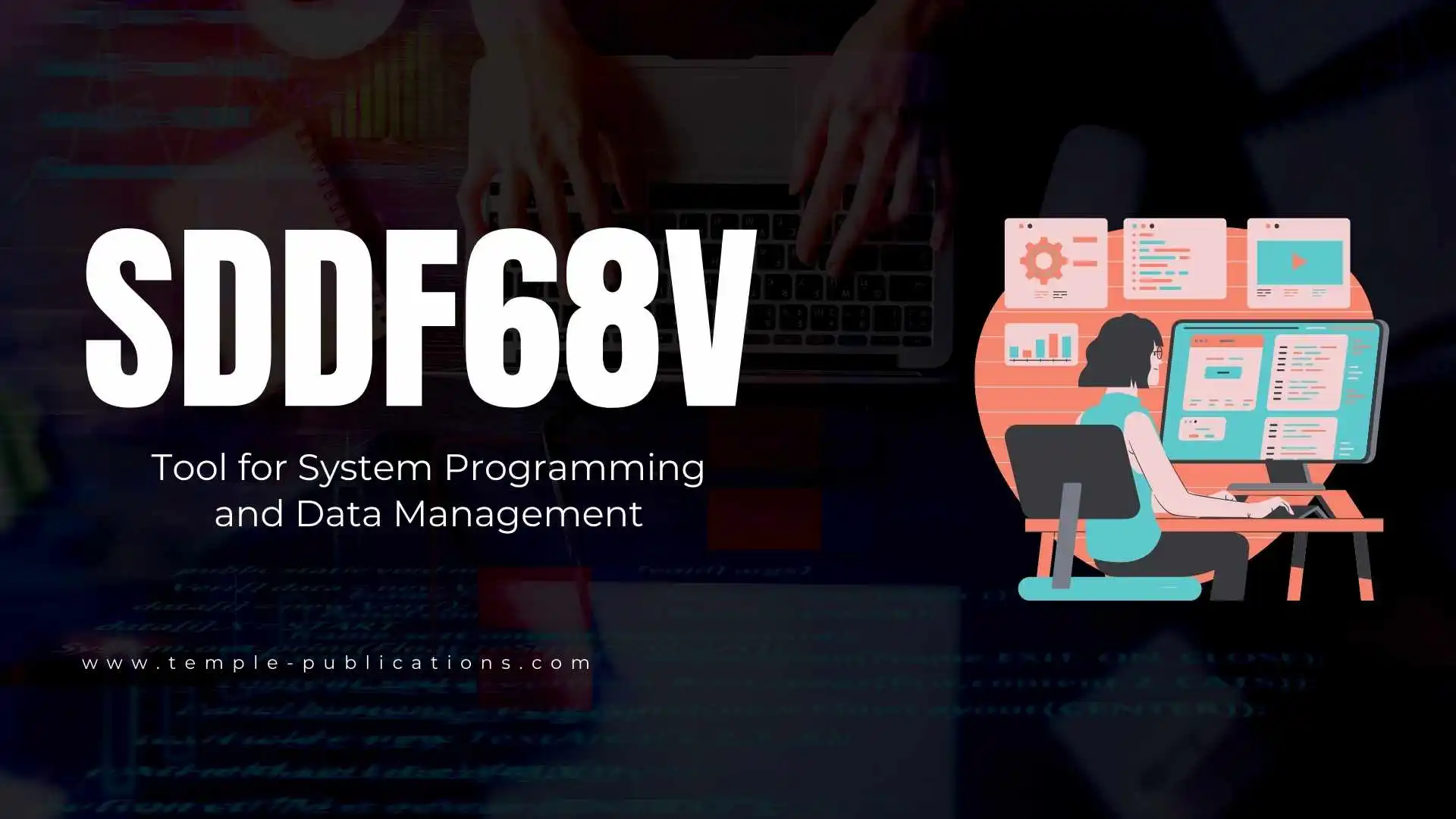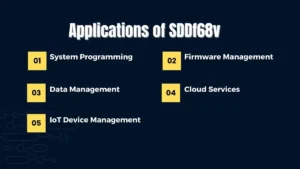TECHNOLOGY
SDDf68v: Tool for System Programming and Data Management

SDDf68v is a cutting-edge software development tool designed for specialized applications in system programming, data management, and device unlocking. Its advanced graphical user interface is more secure but requires further flexibility especially when applied in the technological application environment. For its reliability and effectiveness, it is a valuable tool in the IoT, firmware, and cloud spaces. By enabling developers to bypass device restrictions and streamline operations, SDDf68v empowers innovation. Its versatility makes it suitable for diverse applications, ranging from debugging system-level code to securely processing large-scale data, positioning it as a cornerstone in modern technological advancements.
Architectural Design of SDDf68v
The architecture of SDDf68v is built on a modular framework, allowing seamless scalability and adaptability. Its core comprises secure communication protocols and an efficient processing engine, ensuring high performance. The modularity facilitates integration with IoT devices and cloud platforms, enabling real-time data exchange and processing. Its design also supports cross-platform compatibility, making it a versatile choice for developers working in diverse technological ecosystems. This architecture is optimized for resource-intensive applications, ensuring that it remains responsive even under heavy workloads. Such a robust foundation underscores its reliability and adaptability in ever-evolving technological landscapes.
Applications of SDDf68v
- System Programming: Facilitates the creation, debugging, and optimization of system-level software, ensuring smooth and efficient operations.
- Data Management: Handles large-scale data processing and encryption in industries like IoT, finance, and healthcare, ensuring data integrity and security.
- IoT Device Management: Simplifies the configuration, monitoring, and communication of interconnected IoT devices, enhancing reliability and performance.
- Firmware Management: Streamlines firmware updates, debugging, and compatibility checks, ensuring seamless device functionality and longevity.
- Cloud Services: Supports secure and scalable integration with cloud platforms, optimizing resource management and enabling robust cloud-based applications.

Benefits of SDDf68v
SDDf68v offers a range of significant benefits that enhance both productivity and security for developers and organizations. THIS combines to make it very useful in simplifying work that is recurrent for instance system programming, data management and device unlocking so that teams can bring innovation. Strong aspects of the tool include encryption as well as secure interfaces hence making sure that sensitive data and systems are not exposed to the wrong hands; thus making the working environment safe. Due to its applicability in different domains such as IoT, cloud computing, and firmware management, it remains the best solution for other different fields. Regular updates, including AI, ML, and emerging technologies like quantum and edge computing, ensure SDDf68v remains future-proof. Ultimately, it provides cost-effective solutions, minimizing downtime and delivering a high return on investment.
Device Unlocking and Security
One of it standout features is its ability to bypass device restrictions ethically and securely. This functionality is crucial for developers involved in firmware management or troubleshooting locked devices. The tool employs advanced security protocols to ensure that unlocking processes remain compliant with legal and ethical standards. Its applications range from upgrading firmware on IoT devices to recovering systems in case of software corruption. These features make SDDf68v a trusted choice for tasks that require precision, security, and compliance, ensuring that device management processes are both effective and risk-free.
Key Features of SDDf68v
- Secure Interface: Ensures encrypted communication and robust data protection, safeguarding systems against unauthorized access.
- Flexible Integration: Compatible with multiple platforms and ecosystems, supporting seamless integration with IoT devices, cloud services, and other technologies.
- Advanced Debugging Tools: Simplifies the identification and resolution of system and firmware issues, minimizing downtime and enhancing reliability.
- Data Management Excellence: Provides tools for efficient real-time data processing, encryption, and storage, tailored for large-scale applications.
- Device Unlocking Capabilities: Enables safe and ethical bypassing of restrictions for firmware updates, troubleshooting, and system recovery.
Security and Compliance
Security is a cornerstone of SDDf68v, with features designed to protect systems and data from unauthorized access Use of encryption standards to safeguard content during transmission or after it has been transmitted via the internet or any other communication channel. Further, the tool also has legal and ethical criteria that it follows to address the current governing standards while the tool is being utilized. Due to the high level of security provided by this blockchain, its use could easily be integrated into areas like finance, healthcare and the growing Internet of Things market where data security is key. This shows that SDDf68v is committed to security and compliance so that the users can focus their energies on creating.

Customization and Scalability
SDDf68v’s modular architecture supports extensive customization, allowing developers to tailor its features to specific needs. Its scalable design ensures that the tool can grow with the user’s requirements, making it a cost-effective choice for organizations of all sizes. From small startups to large enterprises, SDDf68v adapts to diverse workflows and processes. This flexibility extends to its integration capabilities, allowing seamless interaction with other tools and platforms. By offering a high degree of customization and scalability, it ensures that it remains relevant in dynamic and evolving technological landscapes.
Future Innovations
SDDf68v is poised to evolve with the integration of advanced AI and machine learning capabilities, offering predictive analytics, automated debugging, and smarter data management. These enhancements will empower developers to address challenges with greater precision and efficiency. Additionally, SDDf68v is expanding compatibility with emerging technologies like edge computing and quantum systems. Edge computing will enable real-time processing and reduced latency, particularly for IoT devices, while quantum compatibility promises solutions for complex computational challenges. These innovations ensure that SDDf68v remains at the forefront of technological trends, providing cutting-edge tools to developers and organizations.
Conclusion
SDDf68v stands out as a transformative tool in the realm of software development, system programming, data management, and device unlocking. Its secure and flexible interface, combined with its broad applicability across IoT, cloud services, and firmware management, makes it indispensable for developers and organizations aiming to innovate and optimize. By offering robust features for debugging, customization, and scalability, it empowers users to overcome complex technological challenges efficiently. Its commitment to security and compliance ensures safe and ethical applications, while its adaptability to future technologies promises enduring relevance. SDDf68v is not just a tool; it’s a catalyst for technological advancement.
-

 BIOGRAPHY7 months ago
BIOGRAPHY7 months agoBehind the Scenes with Sandra Orlow: An Exclusive Interview
-

 HOME1 year ago
HOME1 year agoDiscovering Insights: A Deep Dive into the //vital-mag.net blog
-

 HOME1 year ago
HOME1 year agoSifangds in Action: Real-Life Applications and Success Stories
-

 BIOGRAPHY1 year ago
BIOGRAPHY1 year agoThe Woman Behind the Comedian: Meet Andrew Santino Wife




























